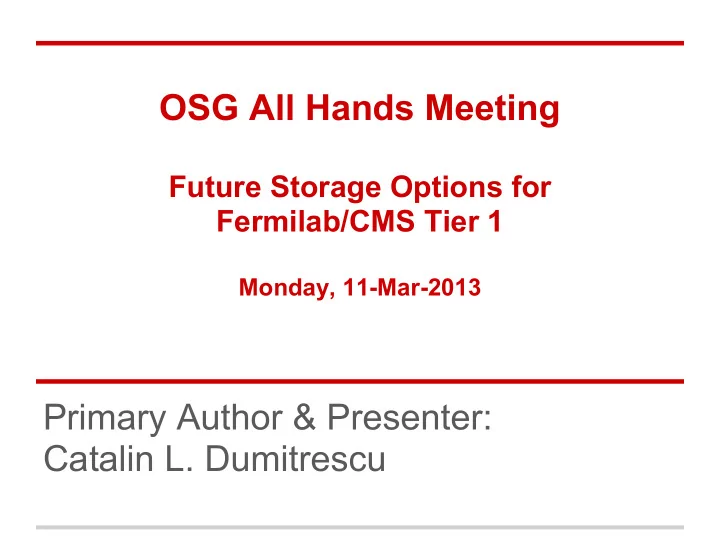

OSG All Hands Meeting Future Storage Options for Fermilab/CMS Tier 1 Monday, 11-Mar-2013 Primary Author & Presenter: Catalin L. Dumitrescu
Introduction ● Data Management is Important ○ LHC has generated useful data (10-15PB/year) ○ In 2015 higher energies are planned ● Fermilab Tier1 continues to provide a larger fraction of the CMS resource share (>40%) ● 2000 local and production users access data ● Remote data access has gain importance through the AAA project
Presentation Overview ● Introduction & Principles Review ● Deployed Systems & Ongoing Issues ● New CMS Requirements ● Ongoing Challenges ● System Growth & Simplification Plans ● Storage Evaluation Results ● Conclusions
Principles Review ● Availability Agreements ○ 98% during collision taking ○ 97% during downtimes ● Consistency and Uniformity for Data Servers ○ hundreds of data servers / 40 PB of data ○ automation in case of failure is a must ● QoS remains important ○ sustainable performance ○ rich feature-set for users and production
Deployed System ● dCache 1.9.5 with PNFS ○ bypassed weaknesses seen over years ○ PNFS performance is monitored carefully ● Lustre still used for small temp area ● xrootd 3.2.7 underneath / remote access ● EOS 0.2.29 / alternate user home areas ● BlueArc for home and data areas ● Total: 5 technologies == difficult to manage
Achievements ● Overall ○ deployed 17PB of storage and 40PB on tapes ○ pass the availability metrics all the time ○ top site for 2012 availability metrics ● dCache & Lustre ○ provide data above users / production expectations ○ access to 40PB of data with 0 downtimes ● EOS ○ highly performant compared to other systems ○ transparent upgrades (at any time)
Space Distribution - 17PB / 40PB ● dCache - 15 PB ● Lustre - 200 TB ● EOS - 520 TB ● BlueArc - 250 TB
New CMS Requirements ● CMS Operations want control via PhEDEx ○ file staging to disk and saving to tape ○ common solutions for simplified data handling ● New protocols and algorithms require also storage reevaluations ● Storage space increases 20% every year (?)
Ongoing Issues ● dCache ○ fragile PNFS - better alternatives available ○ sync to the next golden release ● Lustre ○ cannot afford network saturation ○ configuration changes (bugs) bring system down ● EOS ○ CERN support only ○ production validation still pending ● Overall (including BlueArc) ○ too many systems to be maintained ○ HW space splitting over different technologies ○ ongoing performance tunings / user education
Challenges for 2013-2014 ● On the fly system upgrade ○ 0 downtimes, easy upgrades ● Helpful monitoring and interfacing tools ● QoS provisioning ● Reduced homegrown tools, performance tunings and local monitoring ● Increased production farms and new remote access patterns (AAA project)
System Growth & Plans ● Target is 18-20PB on a single technology ● Support for new protocols (xrootd, POSIX) ● Higher performance and reliability from one single storage (instead of dCache + Lustre) ● Upgrades through migration: ○ build a new instance - 80% of the space ○ reduce the tape backend instance - 20%
Evaluation Criterias ● Minimal performance requirements ○ 100Hz for operations ○ 0.7GB/s for tape writing ● reliability ○ less unplanned & planned downtimes ○ data available when needed and with minimal effort ● POSIX interface (users) ○ EOS has proved its importance ● CMS needed protocols ○ xrootd is largely used for production / CMSSW ○ POSIX interface is useful
Considered Solutions ● dCache 2.2.7 ○ handles large amounts of data, POSIX interface, performance, good support and long term development plans ● EOS 0.2.29 ○ POSIX interface, xrootd, easy deployment on SLF5 or SLF6 ● Hadoop 2.0 ○ OSG support, additional tools available, POSIX interface ● Lustre 1.8.6 ○ POSIX interface
Testing Setup and Approach ● Environment ○ 270 test nodes connected over 1GB/s ○ 1 to 100 testing threads / node ○ pool of 100 files ○ load increase every 1 second ● Advantages ○ identification of service saturation ○ identification of breaking point ○ easy to find performance vs. clients
Evaluation Results - SRM ● OPs for distributed load from 300 nodes ; thousands of threads
Evaluation Results - SRM ● Response time for the same load
Evaluation Results - xrootd ● xrootd OPs for clients from 300 nodes and thousands of threads
Evaluation Results - dcap ● dCache / dcap evaluation for clients running on 300 nodes
Planning for the Future ● Authorization schemas ○ SSL implementation ○ GSI evolution support ○ GUMS evolution support ● Protocols ○ SRM scalability / development ○ xrootd ○ other protocols ● Easy of use ○ support for known protocols and interfaces ○ easy of deployment on various OSs
Deploying with the Future in Mind ● Why splitting? ○ plan with safety in mind ○ possibility for replacement ● Why one (or few) technologies? ○ learning curve reduction ○ keeping with updates and less effort ● Why dCache? ○ performance is acceptable ○ support and development plans are strong ○ new technologies incorporation is ongoing ○ Enstore integration is unique
Conclusions ● It is difficult to predict ○ next steps are expected to provide a stable system for at least 1 to 2 years ● Testing and results are important ○ help in ensuring that dCache scales if right protocols are used ○ improve requests for development directions ● Collected experience is important ○ dCache has worked ○ EOS is liked by users and very easy to manage
Questions?
Recommend
More recommend